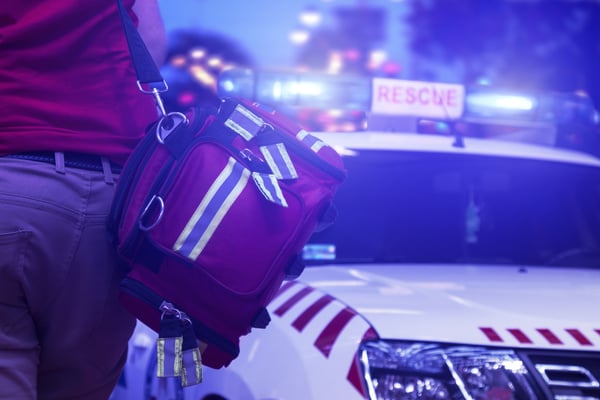
When transporting a critically ill patient, it’s easy to focus only on the medical emergency. But ambulance crashes are common – more than 6,500 ambulance crashes occur each year, claiming an average of 33 lives annually. Ambulance safety depends on taking proactive steps to mitigate risk in the event of a crash.
The Society of Automotive Engineers (SAE) issues safety standards for all vehicles, including ambulances. Compliance with these standards is one of the best things you can do to maintain ambulance safety.
SAE J3027: Secure Patient Cot
This standard requires that a patient’s cot be configured and secured in such a way that neither the cot nor the patient moves forward more than 14 inches in the event of a crash. The previous standard was 30 inches. Additionally, this standard requires that litter be secured in the ambulance. Trash, disposable medical supplies, and other small objects might not seem dangerous. But in a crash, they can become projectiles, endangering everyone in the vehicle. The safest option is to remove all litter except that which is necessary for the maintenance of patient health.
SAE J3026: Patient Compartment Security
Previous SAE standards recognized that people in the patient compartment might need extra mobility to support patient care, so there was no requirement that patient compartments be as secure as other areas of the ambulance. The latest standard requires the same security as other compartments. Seats must be installed according to the manufacturer’s recommendations – so no aftermarket installations – and must be crash-tested. This protects your team in the event of a crash, ensuring they can continue providing patient care.
SAE J3043: Secure Equipment Mounts
SAE J3043 is a critical standard change to develop testing standards for equipment mounts. A piece of equipment that comes loose in a crash can pose a critical danger, especially if that equipment is heavy or has small parts that can dislodge and become projectiles.
The goal of this standard is to provide manufacturers and consumers with details about which mount-securing techniques are safe and effective. Where appropriate, the standard aims to empower manufacturers to make changes that improve safety.
Other Safety Strategies
These safety standards marked a shift toward ensuring that ambulance passengers are as safe as passengers in other vehicles. Ambulances must meet crash test standards, but it’s important to note that much about ambulance safety depends on passengers. Here are some simple strategies you can adopt to remain in compliance and bolster safety:
- Wear your seatbelt and secure your patients. Most people involved in fatal ambulance crashes are not wearing seatbelts. Your seatbelt can save your life.
- Keep the ambulance clean. This makes it easier to find critical equipment when you need it. It also ensures that litter does not become a dangerous projectile in the event of a crash.
- Ensure drivers follow rules of the road, especially when transporting in a non-emergency situation. And pay attention. Distracted driving is the leading cause of auto accidents today.
- Use seat belts correctly. Of the 44% of patients ejected from their cots, many were not restrained with both shoulder and lap belts. Using lap belts alone puts patients at higher risk of becoming projectiles and injuring themselves or others in the compartment.
In an increasingly safety-conscious climate, a heavy wall-mounted suction unit is impractical, even for the largest buses. Portable suction devices are easy to secure, easy to maneuver in high-stress tactical scenarios, and highly effective at clearing the airway. For help choosing the right one for your agency, download our free guide, The Ultimate Guide to Purchasing a Portable Emergency Suction Device.
Editor's Note: This blog was originally published in September 2022. It has been re-published with additional up-to-date content.















